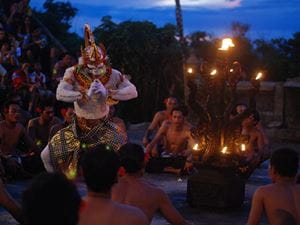
Pranav Seth / Flickr
Hanuman Jayanti celebrates the birth of Lord Hanuman. Hanuman was the son of Anjana, a female spirit of the clouds and waters, and Desari, the chief of the vanara, a group of powerful monkey people who lived in the forests. The wind god Vayu also played a role in the conception and birth of Hanuman. Some texts identify Hanuman as an incarnation of Shiva, but Hanuman is best known for his role in the epic poem and sacred text the Ramayana, “Rama’s Journey.”
The Ramayana tells the story of the divine prince Rama. Rama was sent into exile unjustly by his stepmother, Kaikeyi. While in exile, Rama’s wife, Sita, is abducted by the demon Ravana. Much of the epic poem is devoted to Rama’s determined quest to rescue Sita from Ravana. Rama successfully recovers Sita and kills Ravana with the help of the vanara. Rama and Sita return to the kingdom of Ayodhya and usher in a golden age of humanity. Rama, the titular character of the Ramayana, is identified as an incarnation, or avatara, of the god Vishnu.
Hanuman plays a central role in the Ramayana, and his stories are nearly always tied to those of Prince Rama, also called Lord Ram. Even before Hanuman’s birth, it was predicted that he would be a devotee of Lord Ram. After he was born, Hanuman was a trouble maker who, among other feats of mischief, tried to grab the sun from the sky. In response, powerful sages cursed Hanuman and made him forget his magic powers. Hanuman became a loyal servant to Rama and a commander of Rama’s legions of monkeys. The memory of his powers was restored to Hanuman by Jambavan, the king of the bears, and as a result, Hanuman made a giant leap across the strait that lies between India and Sri Lanka to steal the medicinal herbs necessary to heal the wounded in Rama’s army. When Hanuman struggled to identify the herbs, he picked up the entire mountain and brought that back to India. Before Hanuman left Sri Lanka, his tail was set on fire. Hanuman, however, used this fire to burn Sri Lanka to the ground.
The Ramayana has multiple characters and relationships that are seen as exemplifying proper conduct. Rama and Laksmana, Rama’s younger brother who goes with Rama into exile, are held up as the perfect example of fraternal love. Sita, meanwhile, is said to be the epitome of womanly purity and virtue. Some modern women, however, take issue with the treatment of Sita in the Ramayana. After her rescue by Rama, Sita undergoes a trial by fire to prove that she was not raped or seduced by Ravana. Despite the fact that her innocence is proven by the gods protecting her from the flames, the people of Ayodhya do not believe that Sita did not sleep, willingly or unwillingly, with Ravana. As such, Sita is sent into exile. She gives birth to a pair of twins before dying. In a country that is still struggling with the treatment of women and the deadly ritual of sati, some people feel that interpretations of the Ramayana need to be updated for the modern age. This idea, of course, is extremely controversial.
Regardless of the debates that swirl around the Ramayana, Hanuman is held up as the embodiment of loyalty and devotion. These admirable traits are recognized year round at temples dedicated to Hanuman and given special attention during Hanuman Jayanti.
During Hanuman Jayanti, Hindus take an early morning holy bath and either attend temples dedicated to Hanuman or perform puja at home if they have their own shrine dedicated to Hanuman. The Hanuman Chalisa is read in order to conquer evil spirits and provide mental peace to those reading and listening. People apply red powder to their foreheads in an echo of how Hanuman covered his whole body in sindoor to ensure Rama’s immortality.
The colorful festival celebrates the coexistence of humanity and nature’s creatures, as represented by Rama and Hanuman. Hanuman is also celebrated as a symbol of devotion, strength, magical powers and energy and also as the 11th Rudra avatara of the great god Shiva. Many devotees pray to Hanuman to be blessed with bravery, intelligence and loyalty like that which Hanuman displayed.
Hanuman is a popular god among Hindus, and his temples are often filled with monkeys who know that humans cannot harm them so long as they are on temple grounds. Hindus, however, are not the only ones who recognize Hanuman. Hanuman also appears in Buddhism, Sikhism and Jainism as well as in Indian pop culture. The Ramayana is one of India’s most beloved stories, and the myth has been retold in a variety of mediums. The television series “Ramayan” aired in India between 1987 and 1988. “Ramayan” drew so many viewers that India came to a standstill when the program aired as everyone with access to a television stopped what they were doing to watch the show. The myth also appeared as a big-budget primetime series in the 2008 show “Ramayana.”
Hanuman has been honored for millennia, and that fact has not changed in the modern age. Thousands still flock to his temples and wear sindoor in recognition of his devotion to Rama. Hanuman himself would likely be pleased with this. There is, after all, something perfect about the determined loyalty of Hindus to the god who was known for his faithfulness.

